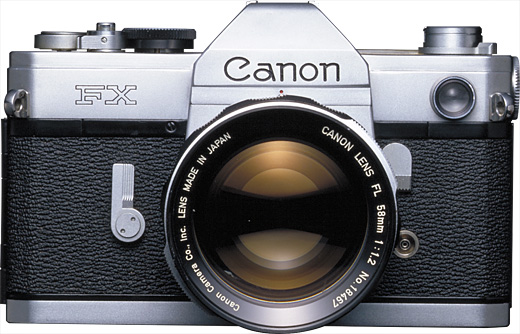
After the Canonflex R-series, the Canon FX was the first in a new series having an aperture linkage on a new lens mount.
The model designation's "flex" (for single-lens reflex) suffix was replaced with an "F."
The new aperture linkage was designed to reduce the film advance torque and to integrate TTL light metering. After the shutter was released, the lens reverted to the maximum aperture regardless of the film advance state.
The built-in CdS exposure meter indicated the proper aperture for the selected shutter speed. A lever switched between the high (EV9 to 18) and low (EV1 to 10) metering sensitivity ranges.
| Shutter | Two-axis, horizontal-travel focal-plane shutter with cloth curtains. Single-axis non-rotating dial for X, B, 1, 1/2, 1/4, 1/8, 1/15, 1/30, 1/60, 1/125, 1/250, 1/500, and 1/1000 sec. Equipped with built-in self-timer. (Time exposures with B and shutter button lock.) |
| Viewfinder | Fixed eye-level pentaprism. Split-image rangefinder at center of fresnel matte screen. Mirror lockup provided. |
| - Magnification | 0.9x |
| - Coverage | 93% |
| Power | - |
| Size | 141.5 x 91 x 86 mm |
| Weight | 670 gr |
Photos tagged for the Canon FX (1964) in the Canon Classics Flickr Group.
The Canon FX, along with it's companion, the Canon FP was introduced in 1964; an interesting time in the photographic world. First however, let's have a look at the photographic world in 1964. First, the Nikon F was well into its long reign as the "professionals" choice. However, few people used a Nikon F, that was reserved for pro photographers and well off people. Most people used Kodak film, and most people use Kodak cameras, especially the Kodak Instamatic, with its drop in square negative cartridge. Finally, most people were shooting color print film, specifically Kodacolor X. 35mm cameras and film were in a distinct minoriity, confined to professionals and the well off. If somebody did use a 35mm camera, it usually had a European pedigree. However, by 1964 Japan Inc. had stolen the lead from the Germans. Granted there were German cameras, notably Leica and Zeiss, but the Leica rangefinder was gradually becoming a niche product, while Zeiss was slowing going out of business in cameras.
So where does that leave the Canon FX? Well, the FX/FP twins introduced a sturdy, well made camera body that would serve Canon well for the next ten years. Secondly, the FX/FP line corrected the design flaws that sank the Canonflex models. Finally, the were accompanied by a new line of lenses, the Canon Lens FL series, which was last until 1971. Sharp and study, they would produce many good images in the hand of as skilled photographer. However, of the two, the FX was clearly designed for an amateur market. Why, because of the built in meter, which read the amount of light from an outside sensor on the rewind knob side of the camera (left being from the camera operators point of view). Even though it was built into the camera body, I remember that the operator had to read the meter scale, located in front of the rewind knob, thsuen transfer the setting to the camera lens. This was cumbersome, but about as good as any other metered camera you could by in 1964. After all, the idea was to market a camera that would help the struggling amateur to get more precise exposure, and more good prints or slides per roll. Finally, the Canon FX was sold not only in camera stores, but in select department stores as well. If you have one in reasonably good condition, given that the Canon FX was introduced almost 50 years ago, it will probably still take pictures, but it may also have the dreaded Canon shutter "gritch." Assuming no other problems a good CLA would likely restore it to working condition. However, be careful with the meter, which was designed for a 1.35 volt mercury cell. It may be possible to make adjustments so it use the A-625 1.5 volt alkaline cell. However, a good clean Canon FX, with a 50mm f1.8 lens, (which uses a hard to find 48mm filter) would be a good collector's camera. Still, if you have one in your drawer, closet or wherever, it would be a good idea to get a roll of 35mm and give your FX some exercise. Finally, though all film cameras except for Leicas and Rollei TLRs have lost a lot of value in the digital years, Canon F series cameras, especially the older models have increased in value largely because of the collector's market. Still, let the buyer beware especially if you get one from eBay. Better to pay more and get one from a reputable online camera seller. However, a Canon FX is not likely to bring as good a price as its partner. I'll explain the reason for that in a review for that camera Good shooting to all.